
The Boeing CH-47 Chinook is a tandem-rotor helicopter originally developed by American rotorcraft company Vertol and now manufactured by Boeing Defense, Space & Security. The Chinook is a heavy-lift helicopter that is among the heaviest lifting Western helicopters. Its name, Chinook, is from the Native American Chinook people of Oregon and Washington state.
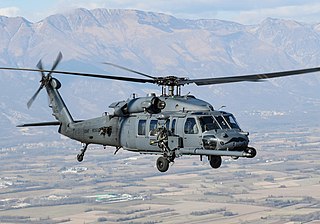
The Sikorsky MH-60/HH-60 Pave Hawk is a four-blade, twin-engine, medium-lift utility military helicopter manufactured by Sikorsky Aircraft. The HH-60 Pave Hawk and its successor the HH-60W Jolly Green II are combat rescue helicopters, though in practice they often serve humanitarian and peacetime disaster rescue. It is a derivative of the UH-60 Black Hawk and incorporates the US Air Force PAVE electronic systems program. The HH-60/MH-60 is a member of the Sikorsky S-70 family.

The Sikorsky MH-53 Pave Low series is a retired long-range special operations and combat search and rescue (CSAR) helicopter for the United States Air Force. The series was upgraded from the HH-53B/C, variants of the Sikorsky CH-53 Sea Stallion. The HH-53 "Super Jolly Green Giant" was initially developed to replace the HH-3E "Jolly Green Giant". The U.S. Air Force's MH-53J/M fleet was retired in September 2008.
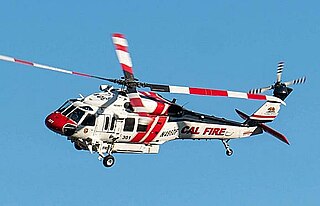
The Sikorsky S-70 is an American medium transport/utility helicopter family manufactured by Sikorsky Aircraft. It was developed for the United States Army in the 1970s, winning a competition to be designated the UH-60 Black Hawk and spawning a large family in U.S. military service. New and improved versions of the UH-60 have been developed since. Civilian versions, and some military versions, are produced under various S-70 model designations.

The Lockheed Martin VH-71 Kestrel was a variant of the AgustaWestland AW101 that was being manufactured to replace the United States Marine Corps' Marine One U.S. Presidential transport fleet. Originally marketed for various competitions as the US101, it was developed and manufactured in the US by a consortium headed by Lockheed Martin, consisting of Lockheed Martin Systems Integration – Owego (LMSI), AgustaWestland and Bell Helicopter.

The 129th Rescue Wing is a unit of the California Air National Guard, stationed at Moffett Federal Airfield in Sunnyvale, California. The wing is equipped with the HC-130J Combat King II and the HH-60G Pave Hawk helicopter. If activated to federal service, the wing is assigned to the United States Air Force's Air Combat Command (ACC).

The United States Air Force Combat Rescue School, was an organization of the United States Air Force.
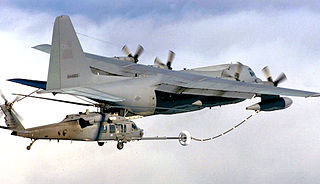
The 106th Rescue Wing is a unit of the New York Air National Guard, stationed at Francis S. Gabreski Air National Guard Base, Westhampton Beach, New York. If activated to federal service, the Wing is gained by the United States Air Force Air Combat Command.

The 920th Rescue Wing is part of the Air Force Reserve Command (AFRC) of the United States Air Force. The wing is assigned to the Tenth Air Force of the Air Force Reserve Command (AFRC).
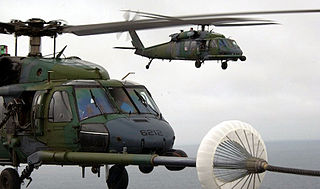
The 101st Rescue Squadron is a unit of the New York Air National Guard 106th Rescue Wing stationed at Francis S. Gabreski Air National Guard Base, Westhampton Beach, New York. The squadron is equipped with the Sikorsky HH-60G Pave Hawk and HH-60W Jolly Green II helicopters, configured for combat search and rescue operations.

The 41st Rescue Squadron is part of the 347th Rescue Group at Moody Air Force Base, Georgia. It operates HH-60W Jolly Green II aircraft conducting search and rescue missions.
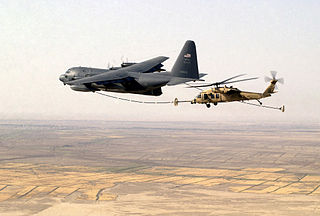
The 39th Rescue Squadron is an Air Force Reserve Command unit of the 920th Rescue Wing at Patrick Space Force Base, Florida. Until December 2019, it operated the Lockheed HC-130P/N Combat King aircraft conducting search and rescue and combat search and rescue/personnel recovery missions. The squadron is currently transitioning to the Lockheed Martin HC-130J Combat King II aircraft, which will provide significant increases in the squadron's capabilities. An Air Force Reserve Command unit, the 39th Rescue Squadron is operationally-gained by the Air Combat Command (ACC) upon mobilization.

The 66th Rescue Squadron is an inactive squadron of the United States Air Force that was last stationed at Nellis Air Force Base, Nevada, where it operated HH-60 Pave Hawk helicopters conducting search and rescue and combat search and rescue missions. At the time of its inactivation in 2023, it was a geographically separated unit of the 563rd Rescue Group, 355th Wing, at Davis–Monthan Air Force Base, Arizona.

The 55th Rescue Squadron is an aviation unit of the United States Air Force. It operates the Sikorsky HH-60W Jolly Green II helicopter and provides rapidly deployable combat search and rescue forces to theater commanders worldwide. 55th used to use the HH-60G Pave Hawk until switching to the HH-60W Jolly Green II. They tactically employ the HH-60W helicopter and its crew in hostile environments to recover downed aircrew and isolated personnel during day, night, or marginal weather conditions. The squadron also conducts military operations other than war including civil search and rescue, disaster relief, international aid, emergency medical evacuation, and counter-drug activities.

The 301st Rescue Squadron is an Air Force Reserve Command unit, part of the 920th Rescue Wing at Patrick Space Force Base, Florida. The squadron operates the HH-60G Pave Hawk helicopter, conducting both peacetime and combat search and rescue missions. As a reserve unit, it is operationally-gained by the Air Combat Command (ACC).

The 303d Expeditionary Rescue Squadron is a provisional unit of the United States Air Force. It is permanently deployed to Camp Lemonier, Djibouti. It was reactivated in 2013 as a forward deployed umbrella organization for rotational Sikorsky HH-60 Pave Hawk and pararescue/Guardian Angel combat search and rescue units of the Air Force Reserve deployed to U.S. Africa Command, specifically to Combined Joint Task Force-Horn of Africa.

The 305th Rescue Squadron is part of the 943rd Rescue Group at Davis–Monthan Air Force Base, Arizona, a subordinate of the 920th Rescue Wing at Patrick Space Force Base, Florida. It operates Sikorsky HH-60G Pave Hawk and HH-60W Jolly Green II aircraft conducting peacetime and combat search and rescue missions.

The 563rd Rescue Group is a United States Air Force unit stationed at Davis-Monthan Air Force Base, Arizona. The group also controls the rescue squadrons at Nellis Air Force Base, Nevada. It is assigned to the 355th Wing. The group directs flying operations dedicated to personnel recovery and is part of Air Combat Command. The group was activated under its current designation at Davis-Monthan in 2003 to command rescue units in the western United States.

The 34th Weapons Squadron is a United States Air Force unit. It is assigned to the USAF Weapons School, stationed at Nellis Air Force Base, Nevada.
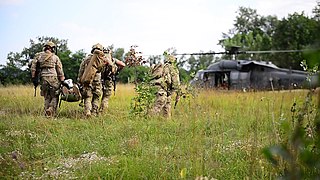
The 57th Rescue Squadron is part of the 31st Operations Group, 31st Fighter Wing at Aviano Air Base, Italy. As part of the 31st Operations Group it conducts pararescue operations in support of higher command directives, at times utilizing HH-60G Pave Hawk and Lockheed HC-130 Hercules aircraft flown by other rescue squadrons such as the 56th Rescue Squadron, also based at Aviano. The 57th Rescue Squadron is a combat-ready squadron of pararescue personnel capable of performing combat rescue and personnel retrieval missions in theaters of operations worldwide. The squadron does not operate any aircraft.





















